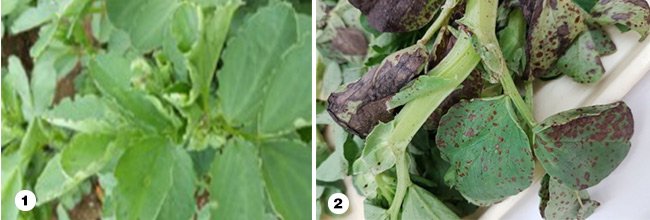Crop Update 8 May 2018
PRE-EMERGENCE HERBICIDES … WINTER BEAN CROPS … PEA AND BEAN WEEVIL … PEA MOTH

1. Typical notching on bean leaves caused by pea and bean weevil 2. Typical symptoms of chocolate spot on winter bean leaves
Pre-emergence herbicides ...
Cost-effective pre-emergence herbicide options are dependent on moisture availability. Additional factors - such as cloddy seedbeds - can influence whether adequate weed control is achieved. Rolling helps conserve moisture and break up clods, and application with appropriate angled nozzles may help if the surface is cloddy.
Several pre-emergence products and tank mixes are available for combining peas and spring beans. In addition to Nirvana, Centium, various pendimethalin products (approved for peas, EAMU beans) and Defy (EAMU beans only), Afalon (linuron) and Linzone/Lingo (linuron + clomazone) are also approved for use in peas and spring beans. The final use date for products containing linuron is 3 June 2018.
Dual Gold (S-metolachlor) has an EAMU and can be used in beans between 1st March and 31st May. Stallion Sync TEC (pendimethalin + clomazone) has approval in both spring peas and beans.
This season there have been several reports of crops emerging before a pre-emergence herbicide has been applied. Either the opportunity to spray has not presented itself since drilling, or the warm wet soils have led to crops emerging quickly - some report within a week, particularly peas.
None of the pre-emergence herbicides have any approval to be used when peas or beans are visible, and several recommend not to apply if shoots are within 13mm of the surface.
Post-emergence broad-leaved weed options are limited in both crops and cannot be applied generally until crops have 2-3 leaf pairs. If growers find themselves in such a situation and wish to discuss this or other herbicide issues, they can contact Jim Scrimshaw at PGRO (0770 300 1497).
Winter bean crops ...
Reports have been received of high levels of chocolate spot in some winter bean crops. This is the result of frost damage predisposing the plants to disease and continued rain throughout February and March. Frost damage is present on older leaves as blackened areas, with more typical chocolate spot symptoms on the younger leaves. Fungicides are protectant and will not cure existing infection.
While weather conditions remain settled, disease development may be slow - but where high levels of existing infection are seen, an early fungicide may be necessary. If conditions are likely to become wet, a fungicide should be applied to prevent further development of the disease.
Pea and bean weevil ...
Pea and bean weevils are very active following the increase in temperature during mid-April. Spring peas and beans that are emerging - or will emerge in the next week to two weeks - will be at most risk of damage.
Although foliar damage doesn’t generally cause a problem, crop growth may be delayed if damage is severe at very early emergence. Spraying will prevent egg laying and larval damage to root nodules.
If there is a history of severe damage in spring peas or beans, a pyrethroid spray should be applied at first signs of leaf-notching, and a second spray ten to fourteen days later.
Winter beans may suffer less damage as they are generally well established by the time weevils are active.
Pea moth ...
Pea moth traps should be placed into pea crops in mid-May. The monitoring system consists of delta traps containing a pheromone attractant. These should be placed in crops just prior to commencement of flowering.
Traps are available from OECOS Limited, 11a High Street, Kimpton, Hertfordshire SG4 8RA. An alternative monitoring system is available from Agralan Ltd, The Old Brickyard, Ashton Keynes, Swindon, SN6 6QR.
When traps are in place, they should be monitored three times each week, and a threshold is reached for combining peas when 10 or more moths are caught in either trap on two consecutive occasions.
Timing of sprays is related to egg development and this is affected by temperature. Starting from the day on which the threshold is reached, growers should record the daily maximum and minimum temperature and set these on the outer scales of the calculator supplied with the Oecos traps. The figures exhibited in the window are added each day until the total reaches 90. Alternatively, a spray date can be obtained from the PGRO website, based on a computer prediction, three to four days after reaching a threshold.
On the predicted spray date, crops which are at the first pod set stage or which have flowered should be sprayed, but later crops should only be sprayed when they reach first pod set. Crops with flat pods are susceptible to damage. A second application should be applied 10-14 days later.
The acceptable level of damage is much lower in vining peas and the threshold catch for combining peas is not suitable. Therefore the traps should be used as a guide as to the presence of moths. In areas where damage has been a problem in the past, crops which are at the first pod set stage should be treated.
For further information, please contact PGRO Technical Advice on 1780 782585, option 2
or email info@pgro.org
For press information, contact PGRO’s PR agency, Ahead Ltd on 01904 634040 mail@aheadpr.eu
Notes for Editors:
1. Processors and Growers Research Organisation (PGRO) is the non statutory levy body which promotes and carries out research and development in peas and beans. PGRO growing guides and recommended lists of varieties are the national references for growers. The PGRO publishes 'The Pulse Magazine' quarterly, the 'Pulse Agronomy App’ on its website (www.pgro.org), issues bulletins during the growing season, provides education and training courses, and runs grower/agronomist meetings around the UK.
2. All PGRO Technical Updates have been revised to include the changes in pesticide availability for peas and beans. PGRO publications are available as free downloads from the PGRO web site www.pgro.org User passwords are available on request through the web site.
3. GDPR Data Protection: You are receiving this because you, or an authorised person in your organisation, has consented to receiving our technical press releases. If you no longer wish to receive such releases from Ahead Ltd, you have the right to opt out of and be removed from our contacts list immediately by replying to this email with the word ‘REMOVE’ in the subject line. Our contacts list is used only by us and will never be passed on to any other organisation. Although we aim to use efficient virus checking procedures, we accept no liability for viruses, and recipients should use their own virus checking procedures. This e-mail originates from Ahead Ltd, Elcock House, Hospital Fields Road York YO10 4DZ



